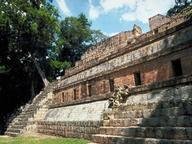Quiz Answer Key and Fun Facts
1. The cover story of this issue featured the tombs of Hegra, Saudi Arabia, which were carved into the natural sandstone cliffs in the first century CE. What similar city, carved from the stone outcrops of Jordan, is this ancient necropolis compared to in the story?
2. An intriguing article in this issue surveys recent work relating to a minority culture in Medieval Europe. Once thought to have been relatively unchanging and steadfastly separate from "mainstream" Europe, excavations are revealing a much more integrated society than texts from the period would suggest. What minority culture is this?
3. Archaeology is a necessarily diverse field, and one story in this issue delves into biology. What line of ancient hominids is covered here--with the unsettling conclusion that some of modern humans' DNA can be traced back to ancestors we may have wanted to forget?
4. Another piece in this issue, "Battle for the Xinjiang Mummies", tells the story of some remarkable 4,000-year-old mummies from China and the political machinations that went into their study. Why were these mummies so politically charged?
5. Another interdisciplinary feature in this issue shows how lasers are being used to map the remains of an ancient Mesoamerican culture whose cities are largely consumed by jungle. What culture is this?
6. A report from a contributing editor tells of mathematical efforts to determine if stone carvings from an ancient Celtic culture consTitute a written language. What group, which lived in northeastern Scotland in the sixth to ninth centuries CE, is this?
7. The ancient history of southern Italy is presumptively associated with the Roman Empire. An article by Samir Patel calls attention to another phase of its development, however: its colonization around 600 BCE. What ancient culture established the colony of Poseidonia, now known as Paestum?
8. A more narrative article discusses how neolithic peoples in Kierikki, Finland adapted to climate change, particularly how settlements did not die out after the warming period known as the "great stone age summer". When was this "great stone age summer"?
9. As the Discovery Times Square Exposition in New York hosted what may be the most famous touring exhibition in history, the uptown Metropolitan Museum of Art staged a parallel offering illustrating how the best-preserved tomb of ancient Egypt was initally prepared. What pharaoh's tomb and funeral were memorialized in these displays?
10. One of the recurring themes in archaeology is that societies or settlements assumed to go back practically to the dawn of humanity are often much more recent. Such appears to be the case in Huasteca, where excavations suggest that the Teenek people are much more recent arrivals than often thought. In what country is Huasteca?
Source: Author
stuthehistoryguy
This quiz was reviewed by FunTrivia editor
bloomsby before going online.
Any errors found in FunTrivia content are routinely corrected through our feedback system.


